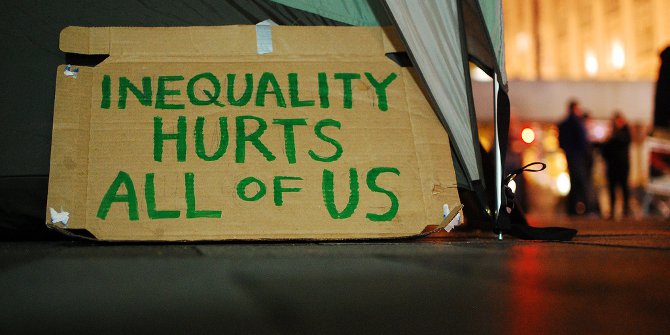Liberal democracy, national determination and economic globalisation are increasingly at odds with one another, which keeps the global governance structure from working smoothly. Eduardo Baistrocchi details a proposal that could be a first step towards solving the problem: a United Nations-controlled platform for standardising international taxation agreements. The idea is to make the international tax regime responsive to the needs and values of people worldwide.
The international tax regime (ITR) faces an existential challenge in the early 21st century. There are good reasons to argue that the world economy is dealing with a trilemma: liberal democracy, national determination and economic globalisation cannot coexist because they are now incompatible. So a central question is how the global governance structure may be adapted to help solve the incompatibility problem and make the international tax regime more responsive to the needs and values of people worldwide.
I outline a proposal that aims to be the first step in solving this problem by setting up a platform under the United Nations’ control for standardising agreements in international taxation. The platform aims to achieve institutional integration between the global north and the global south in the international tax regime.
The legal treatment of standardisation agreements in EU antitrust law inspires the proposal, which has been designed to be compatible with two existing frameworks: the Framework Convention for the Promotion of Inclusive and Effective International Tax Cooperation, approved by a UN General Assembly resolution in 2023; and the Inclusive Framework on Base Erosion and Profit Shifting, established by the OECD and G-20 in 2016.
The platform we envision would consist of four building blocks:
- The UN Global Committee on Proposals for Standardisation Agreements (UN Tax Committee),
- The OECD’s Centre for Tax Policy and Administration,
- The UN General Assembly and
- The UN Global Observatory
Figure 1 – The proposed UN Platform for Tax Standardisation Agreements

The first three building blocks would serve the role of agreeing on the international tax standards on an ongoing basis (the Conference of the Parties), while the fourth one, the UN Global Observatory, would monitor and offer feedback to the Conference of the Parties on the interpretation and application worldwide of the agreed standards to further improve their effectiveness.
Building block 1, the UN Tax Standardisation Committee, is tasked with creating the first draft of the material international tax standards. The committee is composed of sixteen members. Eight represent developed countries (the global north), comprised of G7 countries and the European Union (EU). The other eight represent developing and emerging countries (the global south), comprised of eight clusters of jurisdictions: the African Union, ASEAN, BRICS, G77, India, Indonesia, Mercosur, and the People’s Republic of China.
Committee members are selected based on their contribution to the global gross domestic product (global GDP). They have one vote per member, and decisions are made based on a simple majority. For instance, if a draft proposal for tax standardisation receives nine votes, with eight votes from the global north and one from the global south (or vice versa), it would be presented as the first draft to the next building block, the OECD’s Centre for Tax Policy and Administration (CTPA).
The OECD CTPA would be responsible for producing the second draft of the standardisation proposal and sending it back to the UN Tax Standardisation Committee for review. If the committee approves this draft, it will be submitted for approval or rejection by the next building block, the UN General Assembly. The decision would be made by a majority vote of the present and voting members, in accordance with Article 18 of the United Nations Charter.
If the proposal is approved, the relevant standardisation agreement could be added, for example, to the UN and/or the OECD Model as soft laws. Or it could become hard law, like the protocol on the taxation of income derived from the provision of cross-border services in an increasingly digitalised and globalised economy. If the proposal is rejected, it will be sent back to the committee for reformulation and a fresh start to the reform proposal process.
Finally, the fourth building block, the UN Global Observatory, will offer feedback to the Conference of the Parties concerning the interpretation and global implementation of the material tax standard. This feedback will enable the UN Committee to assess the overall impact of the standardisation agreements on the functioning of the ITR and suggest further enhancements.
The platform is compatible with current reforms discussed by the Inclusive Framework on Base Erosion and Profit Shifting established by the OECD and G-20 in 2016.
To ground the proposal submitted here, we need to answer four questions: (1) Why should the G7 and the EU represent the Global North with eight votes in the UN Tax Standardisation Committee? (2) Why should the Global South be represented by the eight clusters of jurisdictions listed in the UN Tax Standardisation Committee? (3) Why the UN General Assembly? and (4) Why should EU regulations on standardisation agreements be transplanted to the ITR?
The G-7 and the EU accounted for over 44 per cent of global GDP in 2023. For almost a century, an increasing number of countries that are now part of the G7 and the EU have been controlling the development of the ITR. Indeed, from 1923 to 2021, the League of Nations and the OECD received 3,419 inputs from various stakeholders on international tax policy preferences. These inputs were submitted at nine significant points in the emergence and evolution of the ITR. Each input represents an observable ITR event that can be considered a proxy for soft power in this area of international law. Input is defined here as a statement made by an endpoint jurisdiction (such as the United Kingdom), an international investor (such as Apple Inc.), a tax hub (such as the Netherlands), or a developing country (such as Brazil) to a relevant supranational institution (such as the League of Nations or the OECD) concerning the discussion leading to a material ITR milestone.
An example of input is an opinion submitted by a country in a meeting led by the relevant supranational institution. When meeting minutes are unavailable, the attendance of each member in each session has been coded as input. Conversely, when the minutes detailing the discussions are available, only participants who state an opinion are coded as inputs.
G-7 countries, tax hubs and developing countries have submitted inputs for the nine reforms that make up the international tax regime’s history: 1) the 1923 Four Economists’ Report; 2) the 1928 League of Nations Model; 3) the 1933 Carroll Report; 4) the 1943 Mexico Model; 5) the 1946 London Model; 6) the 1963 OECD Model; 7) the 1998 Harmful Tax Competition Project; 8) the 2015 Base Erosion and Profit Shifting (BEPS) Report; and 9) the 2021 BEPS Report.
The G-7 countries have contributed the most inputs to the relevant institution across all nine milestones. This historical trend indicates that the G-7 nations have been the primary soft power in making the ITR by submitting the highest percentage of inputs to the League of Nations and later to the OECD. The G-7 jurisdictions have controlled the initial drafts for most of the nine reforms that make up the ITR milestones.
This proposal suggests that the G-7 countries and the EU should have eight out of sixteen votes in the UN Tax Standardisation Committee. The allocation of these positions would be based on their contribution to the global GDP as well as their influence in the evolution of the ITR during its first century. The remaining eight spots would be given to groups of jurisdictions from the global south, as mentioned earlier, in recognition of their contribution to the global GDP, which was over 44 per cent in 2023.
The UN General Assembly plays a crucial role in evaluating the reform proposals produced by the UN Committee with the feedback from the OECD CTPA. This evaluation process grants all 193 UN jurisdictions a voice and offers moral legitimacy to the platform. .
We suggest that the principles followed by the EU for standardisation agreements be used as inspiration for the platform. This includes openness, transparency, and non-discrimination. This transplant is justified as the ITR is a decentralised competitive network market similar to those governed by EU antitrust regulations like two-sided platforms. The EU antitrust regulations could apply, if the platform decides to follow it, as interpreted by the EU Court of Justice.
In sum
We propose the creation of the UN Platform for Standardisation Agreements in the international tax regime, in order to solve the problem of incompatibility and implement the framework convention recently mandated by the UN General Assembly. This new platform’s goal is to empower weaker actors, such as developing countries, by building cross-issue coalitions to increase their bargaining power and influence in international taxation. The concept of standardisation agreements could serve as a good starting point in the search for a new global social contract in this critical area of international law.
- This blog post is based on Global Tax Hubs, Florida Tax Review, Spring 2024 (forthcoming) and LSE Legal Studies Working Paper No. 28/2023 and first appeared at the LSE Business Review blog.
- Featured image provided by Shutterstock
- Please read our comments policy before commenting
- Note: The post gives the views of its author, not of USAPP– American Politics and Policy, nor of the London School of Economics.
- Shortened URL for this post: https://wp.me/p3I2YF-e0r






